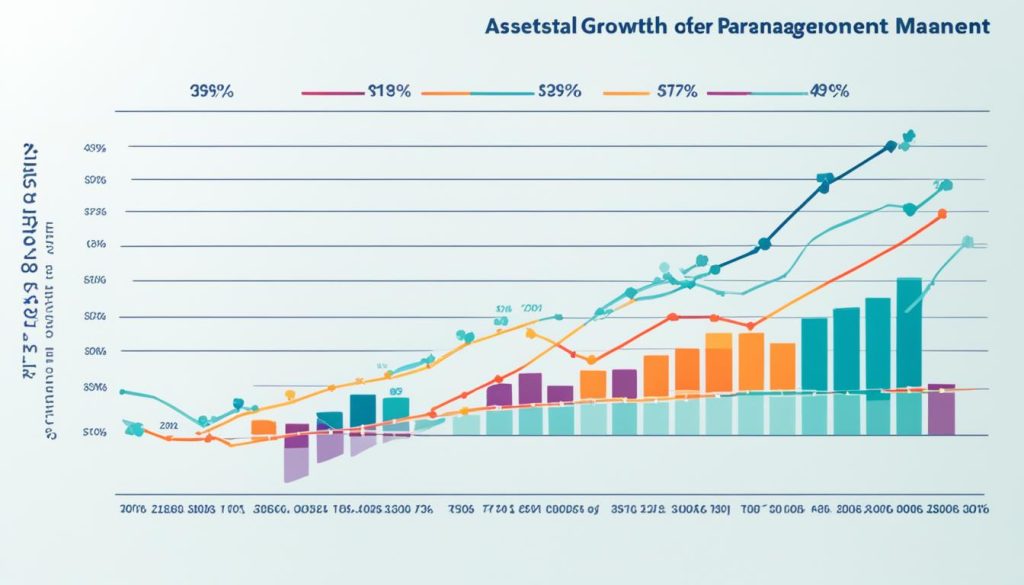Valuing a wealth management firm is crucial for effective financial planning and business growth. It goes beyond portfolio management and involves understanding the unique goals and challenges of the clients. Effective planning for the future, recognizing the value of human capital, and knowing one’s worth are important aspects to consider when valuing a wealth management firm.
When it comes to financial planning and growth in the wealth management industry, understanding the value of your firm is essential. By accurately valuing your firm, you can determine its true worth and make informed decisions for your future.
Valuation methods and approaches vary, but they all aim to determine the fair market value of your firm. Income-based methods, such as discounted cash flow analysis and capitalization of earnings, can provide insights into your firm’s earning potential. Market-based methods, on the other hand, compare your firm to similar businesses in the industry.
Factors that should be considered when valuing a wealth management firm include assets under management (AUM), revenue and profitability, client base and retention rate, the expertise and experience of the management team, reputation and brand value, and growth prospects. Additionally, market conditions, regulatory environment, and industry trends should also be taken into account.
Key Takeaways
- Valuing a wealth management firm is crucial for effective financial planning and growth.
- Understanding the value of your firm is important for making informed decisions about its future.
- Valuation methods include income-based and market-based approaches.
- Factors to consider when valuing a wealth management firm include AUM, revenue and profitability, client base, management expertise, reputation, and growth prospects.
- Market conditions, regulatory environment, and industry trends also impact the valuation.
Methods and Approaches for Valuing a Wealth Management Firm
Valuing a wealth management firm requires the use of various methods and approaches. These methods help determine the worth of the firm, taking into account its financial performance, market conditions, and the purpose of the valuation.
One common method used to value a wealth management firm is the income-based approach. This approach involves analyzing the firm’s future cash flows and determining its present value. Examples of income-based methods include discounted cash flow analysis and capitalization of earnings. By estimating future earnings and discounting them back to the present, these methods provide an indication of the firm’s value.
“The income-based methods allow us to assess the future cash flows of a wealth management firm and determine its intrinsic value.”
Another approach used in valuing a wealth management firm is the market-based approach. This approach relies on comparing the firm to similar transactions or using multiples based on industry standards. Comparable transactions involve analyzing recent sales or acquisitions of similar wealth management firms to determine their value. Multiples, such as price-to-earnings or price-to-assets, are applied to the firm’s financial metrics to estimate its value.
“The market-based methods provide a benchmark for valuing a wealth management firm by comparing it to similar firms in the industry.”
The choice of valuation method ultimately depends on the specific circumstances and goals of the valuation. Some firms may prioritize the income-based methods to assess their future financial prospects, while others may rely on the market-based methods to evaluate their relative position in the industry.
It is worth noting that valuation is not a one-size-fits-all process. Wealth management firms may employ a combination of methods and approaches to gain a comprehensive understanding of their value and develop effective financial planning strategies for growth.
The following table presents a comparison of income-based and market-based methods for valuing a wealth management firm:
| Income-Based Methods | Market-Based Methods | |
|---|---|---|
| Approach | Discounted cash flow analysis, capitalization of earnings | Comparable transactions, multiples |
| Focus | Future cash flows and earnings potential | Industry benchmarks and market comparables |
| Strengths | Detailed analysis of firm’s financial performance | Reliance on recent transactions and industry data |
| Limitations | Dependent on accurate future projections | Market comparables may not accurately reflect firm’s unique attributes |
Finding the Right Valuation Approach
When choosing a valuation approach for a wealth management firm, it is crucial to consider the firm’s specific circumstances and objectives. If the firm has a track record of stable and predictable cash flows, an income-based approach may provide a more accurate valuation. On the other hand, if the firm operates in a dynamic market with frequent mergers and acquisitions, a market-based approach may be more appropriate.
It is recommended to consult with industry experts and valuation professionals to determine the most suitable valuation method for a wealth management firm. By selecting the right approach, firms can gain a clear understanding of their value and make informed decisions to drive financial planning and growth.
Factors to Consider When Valuing a Wealth Management Firm
Valuing a wealth management firm requires careful consideration of various factors. These factors play a crucial role in determining the overall worth and potential of the firm. When conducting a valuation, it is essential to analyze the following key factors:
- Assets Under Management (AUM): A significant factor to consider is the firm’s AUM. This metric represents the total value of client assets being managed by the firm. A higher AUM reflects the firm’s ability to attract and retain clients, indicating a successful track record.
- Revenue and Profitability: The revenue generated by the firm and its profitability are important indicators of its financial health. Analyzing the firm’s income streams, profit margins, and sustainable revenue growth over time provides insights into its financial stability and future prospects.
- Client Base and Retention Rate: The size and loyalty of the firm’s client base are key factors in assessing its value. A well-diversified and expanding client base indicates the firm’s ability to attract new clients and retain existing ones. Higher client retention rates suggest strong client relationships and satisfaction.
- Expertise and Experience of the Management Team: Evaluating the skills and experience of the management team is critical. A competent and experienced team, with deep industry knowledge and a proven track record, instills confidence in the firm’s ability to provide top-tier wealth management services.
- Reputation and Brand Value: The reputation and brand value of a wealth management firm can significantly impact its valuation. A strong brand and a positive reputation built on trust and client satisfaction can differentiate a firm from its competitors and attract a loyal client base.
- Growth Prospects: Assessing the firm’s growth prospects is crucial for determining its future value. Consider factors such as market trends, demographic shifts, technological advancements, and regulatory changes that may impact the firm’s ability to expand its client base and increase revenue.
- Market Conditions, Regulatory Environment, and Industry Trends: Analyzing the broader economic and regulatory landscape is essential. External factors such as market conditions, industry trends, and regulatory changes can influence the firm’s growth potential, risk profile, and long-term sustainability.
By considering these factors, wealth management firms can gain a comprehensive understanding of their value and position in the market. This knowledge is crucial for making informed business decisions, attracting investors, and planning for future growth.

| Factors to Consider | Description |
|---|---|
| Assets Under Management (AUM) | The total value of client assets managed by the firm |
| Revenue and Profitability | The firm’s income streams, profit margins, and sustainable revenue growth |
| Client Base and Retention Rate | The size, loyalty, and satisfaction of the firm’s client base |
| Expertise and Experience of Management Team | The skills, knowledge, and track record of the firm’s management team |
| Reputation and Brand Value | The firm’s reputation, brand recognition, and client perception |
| Growth Prospects | The firm’s potential for future growth and expansion |
| Market Conditions, Regulatory Environment, and Industry Trends | External factors that impact the firm’s growth, risk, and sustainability |
Financial Metrics and Indicators Used in Valuing Wealth Management Firms
Several financial metrics and indicators play a significant role in valuing wealth management firms. These metrics provide valuable insights into the firm’s financial performance and overall health, allowing stakeholders to make informed decisions. By analyzing these metrics, wealth management firms can determine their value and drive strategies for growth and success.
AUM Growth Rate
One of the key metrics used in valuing wealth management firms is the Assets Under Management (AUM) growth rate. This metric measures the rate at which the firm’s AUM is increasing over a specific period. A higher AUM growth rate indicates successful client acquisition and retention, showcasing the firm’s ability to attract and manage assets effectively.
Revenue Growth Rate
The revenue growth rate is another important indicator of a wealth management firm’s value. This metric measures the percentage increase in revenue over a specific period. A higher revenue growth rate signifies the firm’s ability to generate more income, which is often associated with strong financial performance and potential future profitability.
Profit Margin
The profit margin is a crucial financial metric used to evaluate a wealth management firm’s profitability. It measures the percentage of revenue that translates into profits after accounting for expenses. A higher profit margin indicates efficiency in managing costs and generating profits, which is an essential factor in determining the firm’s value.
Return on Assets (ROA)
The Return on Assets (ROA) is a financial ratio that measures the firm’s ability to generate profits from its assets. It calculates the percentage of net income generated relative to the total assets employed. A higher ROA indicates effective utilization of assets and an efficient operating model, which contributes to the firm’s overall value.
Return on Equity (ROE)
The Return on Equity (ROE) is a financial ratio that measures a wealth management firm’s profitability relative to the shareholders’ equity. It calculates the percentage of net income generated relative to the shareholders’ investment. A higher ROE suggests effective capital allocation and efficient use of shareholder funds, contributing to the firm’s overall value.
Client Acquisition Cost
The client acquisition cost is a financial metric that evaluates the cost incurred by a wealth management firm to acquire new clients. It encompasses marketing expenses, sales efforts, and other relevant costs. Monitoring and minimizing this cost is important for optimizing profitability and enhancing the firm’s overall value.
Client Retention Rate
The client retention rate measures the firm’s ability to retain its existing clients over a specific period. A higher client retention rate is indicative of strong client relationships, effective client service, and trust, which contribute to the firm’s stability and long-term value.
Average Revenue per Client
The average revenue per client is a metric that calculates the average income generated per client. It provides insights into the firm’s ability to generate revenue from its client base. Higher average revenue per client suggests that the firm is successfully providing value-added services and generating higher revenue streams.
Net Promoter Score (NPS)
The Net Promoter Score (NPS) is a customer satisfaction metric used to assess the loyalty and satisfaction of wealth management firm clients. It gauges the likelihood of clients recommending the firm to others. A higher NPS indicates a higher level of client satisfaction and loyalty, which are crucial factors in determining the firm’s value and long-term growth potential.
By analyzing these financial metrics and indicators, wealth management firms can gain a deeper understanding of their financial performance and overall value. The insights provided by these metrics inform strategic decision-making, enabling firms to optimize their operations, attract new clients, retain existing clients, and drive growth in a competitive landscape.

Case Studies and Examples of Valuing Wealth Management Firms
Valuing wealth management firms is a complex process that requires careful consideration of various factors and valuation methods. To gain practical insights into this process, let’s explore some real-life case studies and examples.
The Case of XYZ Capital Management
XYZ Capital Management is a renowned wealth management firm with a solid track record. During their valuation process, they experienced rapid growth in assets under management (AUM) due to their exceptional investment strategies and dedicated client service. As a result, their valuation increased significantly, highlighting the significance of AUM growth and financial performance in valuing wealth management firms.
Another compelling example involves ABC Wealth Advisors, a boutique firm specializing in high net worth clients. Despite having a smaller client base, ABC Wealth Advisors demonstrated exceptional client retention and a strong reputation in the industry. These factors positively influenced their valuation, proving that factors beyond AUM and revenue can play a crucial role in determining a firm’s worth.
Key Takeaways
- Case studies provide real-world examples of how valuation methods and factors impact the value of wealth management firms.
- Rapid growth in AUM and strong financial performance can lead to higher valuations.
- Factors such as client retention rate and reputation can also influence a firm’s worth.
By studying these case studies and examples, we can better understand the complexities and nuances involved in valuing wealth management firms. It is essential to consider both quantitative and qualitative factors to arrive at a comprehensive valuation that accurately reflects a firm’s true value and potential for growth.

| Case Studies | Valuation Methods | Factors Considered |
|---|---|---|
| XYZ Capital Management | Discounted cash flow analysis, AUM growth rate | AUM growth, financial performance |
| ABC Wealth Advisors | Comparable transactions, reputation | Client retention rate, reputation |
Strategies for Optimal Financial Planning and Growth in Wealth Management Firms
When it comes to achieving optimal financial planning and growth in wealth management firms, implementing effective strategies is essential. These strategies encompass various aspects of the business, enabling firms to navigate the dynamic landscape and stay ahead of the curve.
Diversifying Revenue Streams
One key strategy for wealth management firms is to diversify their revenue streams. Relying solely on one source of income can be risky, especially in uncertain market conditions. By offering a range of services or exploring new markets, firms can mitigate risks and ensure a steady flow of revenue.
Expanding the Client Base
Expanding the client base is another important strategy for wealth management firms. By reaching out to new demographics, targeting specific niches, or exploring untapped markets, firms can attract a diverse range of clients. This not only helps to expand the firm’s reach but also ensures a broader pool of assets under management.
Enhancing Service Offerings
To differentiate themselves from competitors and attract clients, wealth management firms need to continually enhance their service offerings. This can involve developing innovative investment strategies, introducing new financial products, or providing personalized solutions tailored to individual client needs.
Investing in Technology and Infrastructure
In today’s digital age, investing in technology and infrastructure is crucial for the long-term success of wealth management firms. This includes adopting advanced portfolio management systems, leveraging data analytics for performance tracking, and ensuring robust cybersecurity measures are in place to protect client information.
Optimizing Operational Efficiency
Optimizing operational efficiency is a strategy that can greatly impact the growth and profitability of wealth management firms. Streamlining processes, automating routine tasks, and implementing effective risk management frameworks can help firms allocate resources more efficiently and focus on value-added client services.
Building Strong Relationships with Clients
Building strong relationships with clients is a fundamental strategy for wealth management firms. By fostering trust, providing exceptional service, and demonstrating a deep understanding of client goals and objectives, firms can cultivate long-term relationships that drive client retention and referral business.
Implementing these strategies can position wealth management firms for long-term success by ensuring sustainable growth, enhancing client satisfaction, and optimizing overall financial planning.

| Strategies | Description |
|---|---|
| Diversifying Revenue Streams | Offering a variety of services or exploring new markets to mitigate risks and ensure a steady flow of revenue. |
| Expanding the Client Base | Reaching out to new demographics, niches, or untapped markets to attract a diverse range of clients. |
| Enhancing Service Offerings | Developing innovative investment strategies, introducing new financial products, and providing personalized solutions. |
| Investing in Technology and Infrastructure | Adopting advanced portfolio management systems, leveraging data analytics, and ensuring robust cybersecurity measures. |
| Optimizing Operational Efficiency | Streamlining processes, automating tasks, and implementing effective risk management frameworks. |
| Building Strong Relationships with Clients | Fostering trust, providing exceptional service, and demonstrating a deep understanding of client goals and objectives. |
Conclusion
Valuing a wealth management firm is crucial for effective financial planning and growth. By considering various methods, factors, and financial indicators, firms can determine their worth and make informed decisions. The process goes beyond simple portfolio management and involves understanding the unique goals and challenges of clients.
Real-world case studies and examples provide valuable insights into the valuation process, showcasing how different factors and methods impact the worth of a wealth management firm. These examples highlight the complexities and nuances involved, helping firms make strategic decisions.
Implementing strategies for financial planning and growth is essential in the competitive landscape of wealth management. Diversifying revenue streams, expanding the client base, and optimizing operational efficiency can position firms for long-term success. By valuing their worth and understanding their growth potential, wealth management firms can optimize their operations and provide superior services to their clients, leading to sustainable growth.




No comments! Be the first commenter?